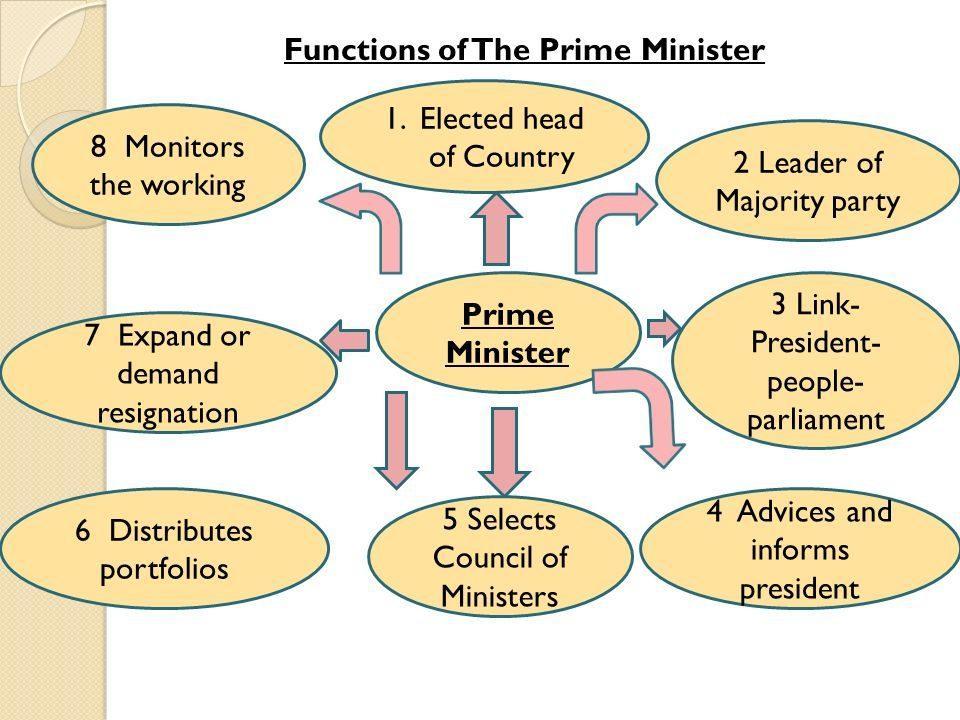Contents
Appointment
- Article 75 of the Indian Constitution specifies that the Prime
Minster is appointed by the President. - The general principle is that the President appoints the leader of the majority party in the Lok Sabha as the Prime Minister
- If no party gets a clear majority then the President may exercise his personal discretion in the appointment of the Prime Minister.
- This power was first executed in India in the year 1979 when Dr Neelam Sanjeeva Reddy appointed Charan Singh as the Prime Minister after the collapse of the Janata Party Government.
- A Minster may be a member of either house of the Parliament. The Prime Minister may be a member of any of the two houses of the Parliament.
- Prime Ministers who were the members of Rajya Sabha
- Indira Gandhi (1966)
- Deve Gowda (1996)
- I K Gujral (1997)
- Manmohan Singh (2004)
Term
- The term of Prime Minister is not fixed.
- The Prime Minister holds the office during the pleasure of the President.
- As long as the Prime Minister enjoys the majority support in the Lok Sabha, he cannot be removed by the President.
Salary
This is determined by the Parliament from time to time.
A minister gets the salary and allowances of that are payable to a Member of Parliament. A Minister is
Resignation
The PM submits his/her resignation to the President of India. When the PM resigns or dies the Council of Ministers stands dissolved.
FUNCTIONS OF THE PRIME MINISTER:
- The PM recommends to the President about the members who can be appointed as the Ministers. Important Note: The President appoints only those persons as Ministers who are recommended by the Prime Minister.
- The PM allocates various portfolios among the Ministers.
- The PM reshuffles the portfolios.
- The PM asks a Minister to resign.
- The PM advises the President to remove a Minister.
- The PM presides over the meeting of Council of Ministers.
- The PM is the principal channel of communication between the President and the Council of Ministers.
Article 78 (Duties of PM)
- It shall be the duty of the Prime Minister to communicate to the President all decisions of the Council of Ministers relating to the administration of the affairs of the Government and proposals for the legislation.
- The PM advises the President with respect to the appointment of Attorney General, Union Public Service Commission Chairman and Members, Comptroller and Auditor General, Chief Election Commissioner and other Election Commissioners, Chairman and members of Finance Commission etc.
- The PM advises the President with regard to the summoning and proroguing of the Parliament.
- The PM recommends the President for the dissolution of Lok Sabha.
- The PM is the Chairman of Planning Commission, National Development Council, National Integration Council, National Population Council, Inter-State Council, National Water Resource Council, National Disaster management etc.
THE COUNCIL OF MINISTERS
The Council of Ministers is headed by the PM. Article 74(1) of the Indian Constitution: There shall be a Council of Ministers headed by the PM to aid and advice the President.
Article 75(2): A minister is individually responsible to the President. It means a Minister hold the office during the pleasure of the President. A Minister submits the resignation to the President. The President can remove a Minister only on the advice of the PM.
STRENGTH
- The original Constitution did not mention
about the strength of the Council of Ministers. - After the 91st amendment act (2003) the strength of the Council of Minister including the Prime Minister should not exceed 15
percent of the total strength of the Lok Sabha (Article 75 (1A)) (Note: Not the total strength of the Parliament). - Article 75(3): The Council of Ministers is collectively responsible to the Loksabha.
APPOINTMENT
- Article 75 (1): The PM is appointed by the President and other Ministers are also appointed by the President on the advice of the PM. A Minister (PM is also a Minister) must be a member of either Loksabha or Rajya Sabha.
- Article 75 (5): If a person who is not a member of either of the houses of the parliament is appointed as the Minister, must become a member of either of the houses of the Parliament within a period of 6 months from the date appointment as the Minister.
- Article 75 (4): The oath of office of a Minister is administered by the President.
DEPUTY PRIME MINISTER
- The office the Deputy Minister is not mentioned in the Constitution. Note: Except Prime Minister, no other Minister is a minister is mentioned in the Constitution.
- So far 6 persons served as the Deputy Prime Ministers of India.
- Sardar Vallbhbhai Patel
- Morarji Desai
- Charan Singh
- Babu Jagjeevan Ram
- Devi Lal
- LK Advani
The word “Cabinet” is not originally mentioned in the Constitution. It was added in Article 352 in the year 1978 through 44th amendment.
MISCELLANEOUS
Important Information regarding various PMs that India had.
- Charan Singh was the only Prime Minister, under whose regime Parliament never met.
- Guljari Lal Nanda was the only interim Prime Minister for 2 times.
- Sardar Vallabhbhai Patel was the first Deputy Prime Minister of India from 1947 – 50.
- Morarji Desai was the first Deputy Prime Minister after the commencement of the Constitution.
- Devilal was the Deputy Prime Minister for 2 times. 1989 and 1990 under the two Prime Ministers V P Singh and Chandra Shekar.
- L K Advani was the last Deputy Prime Minister of India.

